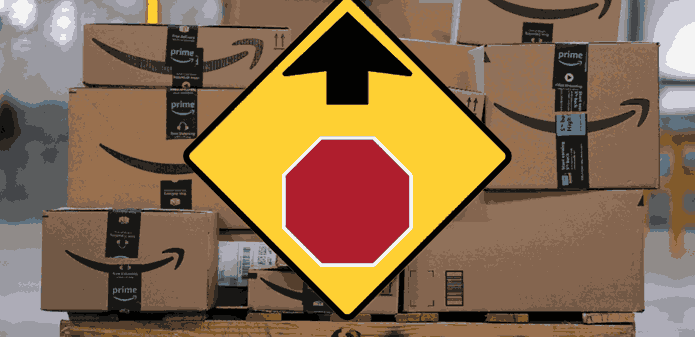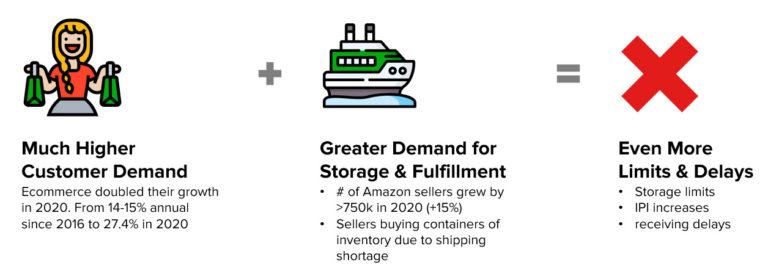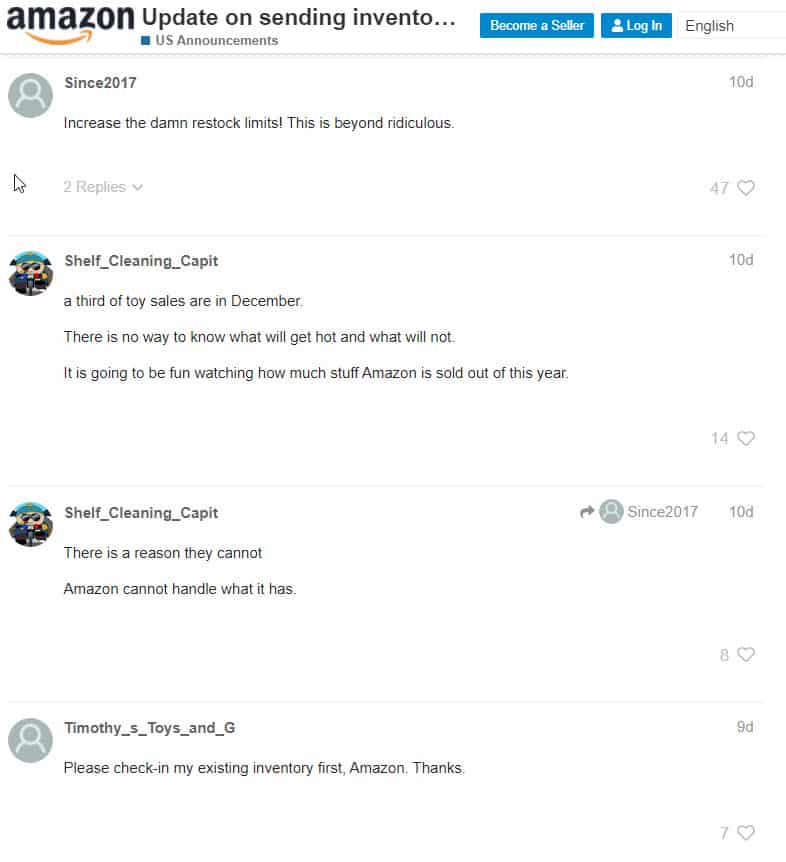Amazon FBA Q4 2021 Inventory Limits Put Merchant’s Earnings in Jeopardy


In this article
Amazon FBA sellers have unfortunately got used to steadily declining inventory limits due to Amazon’s inability to keep up with demand. Read on to learn more about changes to FBA inventory this holiday season, what you should do to maximize your limits, and how you can de-risk your holiday season with Amazon FBM.
What are the new limits?
Amazon FBA sellers were already hit with 20-65% drops in their inventory storage limits in April 2021 when Amazon changed from ASIN-level quantity limits to storage-type quantity limits – and they’re now sweating even lower limits as the holidays approach.

Amazon doesn’t publicize exactly how they calculate sellers’ limits, but sellers have been dismayed in recent weeks to see their restock numbers drop. FBA seller groups are lighting up with merchants whose holidays are all of a sudden in jeopardy – this comment on Telegram is emblematic of the challenge, “Hi, any advice on how to deal with Amazon decreasing restock limits to a third of what it was?”. The responses are befuddled: “Your IPI seems good”. What’s a seller to do?
On top of that, Amazon suddenly changed their Christmas receiving deadline from December 11th to December 2nd. The comments on the announcement, made October 8th, reveal a common theme.

Frustrated sellers plead with Amazon to increase restock limits, but help isn’t coming. Amazon FBA’s history is instructive: over and over, they’ve made it harder to get inventory into FBA, not easier. This holiday receiving deadline is just one more seller-unfriendly change in a long history of negative changes.
How can merchants maximize their Amazon FBA IPI score?
If a seller is determined to only use Amazon FBA, then they need to maximize their IPI score to increase their inventory limits. The FBA Inventory Performance Index (as it’s known formally) measures how efficiently and productively Amazon sellers are managing their inventory. Our Amazon IPI deep dive tells you everything you need to know, but we’ve also included the critical information here.
IPI score is based on four factors:
- Excess inventory
- Sell-through rates
- Stranded inventory
- In-stock inventory
To be fair, reducing excess inventory isn’t the challenge on most sellers’ minds these days. Still, keep an eye on whether particular SKUs aren’t selling well and thus have months worth of product backed up in Amazon’s warehouses. Those are good candidates for removal or disposal orders, which immediately improve IPI score. When it comes to FBA inventory, the 80/20 rule is a bit different from normal: if just 20% of your SKUs are slow movers, they can still torpedo your overall score. You can’t get away with 80% effectiveness – you need 100%.
Next, look to maximize your sell-through rates to improve your IPI score and thus your inventory limits. It’s simple: sell-through rate is equal to the Total Sales of each ASIN divided by the Average Inventory Level of each ASIN for the last 90 days. Of course, every seller wants to improve their sell-through rate; this means lots of sales! The challenge, though, is that an improvement in sell-through rate means faster and faster replenishment orders. Sellers need to be ready to send replenishments as often as three or more times a week if they want to maximize sell-through rate.

Stranded inventory hurts IPI score and is bad for business. Occasionally inventory in FBA gets inadvertently listed as FBM and thus gets stranded. Sometimes it’s a situation where the listing itself has been closed. It is also possible that pricing triggers an alert, and Amazon shuts down the listing to prevent it from selling outside of the minimum or maximum selling price set by the merchant. Keep a close eye on your seller tools and fix any issues with stranded inventory ASAP.
Finally, avoid FBA stockouts at all costs. This is an immense challenge in Q4, as sellers who have been increasing their sell-through rates become more and more vulnerable to a surge in demand (say, from the holidays). The surge can easily knock a SKU out of stock, which triggers a death spiral of lost search rank, lower IPI score, and lower inventory limits. There’s only one reliable way to avoid stockouts – duplicate Amazon FBM listings. With a duplicate FBM listing powered by the merchant or an FBA alternative, sellers can rest easy knowing that if there’s a run on their Amazon FBA stock, they can turn on their FBM listing and keep selling without risking their business.
How to use Amazon FBM to grow this holiday season
Amazon FBM isn’t just a good tool to grow on Amazon – it’s also the key that will unlock multichannel ecommerce sales. As we explained in the last section, Amazon FBM is a seller’s best way to avoid FBA stockouts and protect their Amazon business. On top of that, though, an excellent FBM approach will enable sellers to profitably grow on other marketplaces and on their own site. A recent Shopify study found that sellers on 3+ ecommerce channels boost their revenue by 200% – but Amazon Multi-channel Fulfillment (MCF) isn’t the answer to shipping for other channels.
First and foremost, fulfilling Amazon orders yourself or with an FBA alternative protects your holiday sales. The challenge for sellers trying to do it themselves is that unless they already have 4+ warehouses strategically placed around the United States, they either have to sacrifice fast shipping or free shipping. Offering 2-day shipping to the entire US from just one location puts the majority of customers in Zones 4 and up, which racks up incredible express rates – likely completely erasing margin. On the other hand, delivery times of 5-7 business days will lose customers left and right in the checkout stage, if they even get there. That’s why most sellers turn to an eCommerce order fulfillment platform to power their FBM.
The right eCommerce fulfillment provider won’t just ship your Amazon orders. The best have built easy integrations with all major marketplaces and shopping carts, so with next to no additional effort, sellers have a single operations solution to all of their sales channels. An effective multi-channel fulfillment and sales strategy will include a partner that powers affordable fast & free shipping. Customers expect fast & free shipping online, full stop. Sellers that meet that need see more impressions, higher conversion, and higher retention, so those that offer it on major marketplaces as well as their own site stand to gain the most.
Related Blog Posts

The Ultimate Guide to Selling and Winning on Amazon Seller Fulfilled Prime
Most people are familiar with the requirements that Amazon expects sellers to meet, but far fewer are aware of the roadblocks that make success hard to achieve. An even smaller number are aware of the strategies they can deploy to meet Amazon’s criteria and surpass them.

Amazon Buy With Prime: A Game-Changer for Customers, But a Trojan Horse for Merchants
For customers, Buy With Prime is a great service, but for ecommerce merchants, it’s a Trojan Horse. Amazon Prime circumvents the entire order checkout process from the merchant’s platform, and payment processing goes through Amazon

Protect Your Amazon Listings from Search Suppression, Hijackers, and Stockouts
Amazon is a competitive platform. You need to have a quality product, excellent listing content, and plenty of reviews to catch the attention of busy consumers
